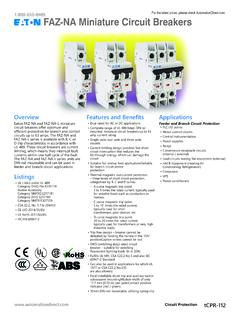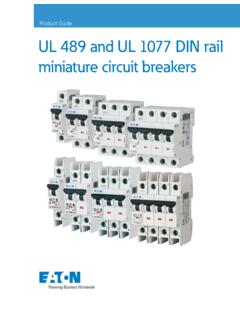Transcription of Molded Case Circuit Breaker Selectivity Guide
1 Technical DataMolded Case Circuit Breaker Selectivity GuideBulletins 140G, 140 MGAdditional ResourcesThese documents contain additional information concerning related products from Rockwell can view or download publications at To order paper copies of technical documentation, contact your local allen - bradley distributor or Rockwell Automation sales picPageIntroduction2 Selectivity2 How to Interpret the Selectivity Tables3 Selectivity : Line Side 140G MCCBs with Load Side Bul. 188-J MCBs, Trip Curves B and C4 Selectivity : Line Side 140G MCCBs with Load Side Bul. 188-J MCBs, Trip Curve D7 Selectivity : Line Side 140G MCCBs with Load Side Bul. 1492-SPM MCBs, Trip Curves B and C10 Selectivity : Line Side 140G MCCBs with Load Side Bul.
2 1492-SPM MCBs, Trip Curve D13 Selectivity : Line Side 140G MCCBs with Load Side 140G G-Frame MCCBs16 Selectivity : Line Side 140G MCCBs with Load Side 140G H-Frame MCCBs19 Selectivity : Line Side 140G MCCBs with Load Side 140G I-Frame MCCBs22 Selectivity : Line Side 140G MCCBs with Load Side 140G J-Frame MCCBs23 Selectivity : Line Side 140G MCCBs with Load Side 140G K-Frame MCCBs25 Back-up Protection26 Back-up Protection: Line Side 140G MCCBs with Load Side MCBs or MCCBs27 ResourceDescriptionMolded Case Circuit Breakers, Motor Protection Circuit Breakers, and Motor Circuit Protectors Technical Data, publication 140G-TD100 Provides specifications for Bul. 140G/140MG Molded Case Circuit Breakers, Motor Protection Circuit Breakers, and Motor Circuit 140G/MG Molded Case Circuit Breaker Specifications, publication 140G-TD047 Provides information on trip curves and time-current curves for Bul.
3 140G/140MG Molded Case Circuit Breakers, Motor Protection Circuit Breakers, and Motor Circuit Circuit Breakers, Fuse Holders and Electronic Circuit Protectors Specifications Technical Data, publication 1492-TD014 Provides specifications for Bul. 1492 and Bul. 188 miniature Circuit Breakers, Fuse Holders and Electronic Circuit Protectors Industrial Automation Wiring and Grounding Guidelines, publication general guidelines for installing a Rockwell Automation industrial Certifications website, declarations of conformity, certificates, and other certification Automation Publication 140G-TD050A-EN-P - July 2016 - November 2016 Molded Case Circuit Breaker Selectivity GuideIntroductionThis document assists the designer of a control system in choosing an allen - bradley Molded Case Circuit Breaker (MCCB) or miniature Circuit Breaker (MCB) for proper coordination in main (primary) and branch circuits.
4 You can choose either Selective Protection or Back-up Protection based on these tables in this publication. The values represent the maximum current [kA], and breaking capacity according to IEC 60947-2 applied for 400/415V AC systems. The 480V/600V table values are represented as Interrupting Ratings, which conform to UL 489 , No. 5 proper selection of protection system helps to maintain safe and economical function of electrical installation and can reduce losses that are associated with unwanted service (2014), Article 100 defines selective coordination as Localization of an overcurrent condition to restrict outages to the Circuit or equipment affected, accomplished by the selection and installation of overcurrent protective devices and their ratings or settings for the full range of available overcurrents, from overload to the maximum available fault current, and for the full range of overcurrent protective device opening times associated with those overcurrents.
5 Trip Selectivity (for overcurrent) is defined in EN/IEC 60947-1 ( ) as coordination between the operating characteristics of two or more overcurrent protection devices, so that when an overcurrent within established limits occurs, the device destined to operate within those limits trips whereas the others do not characteristics of Circuit breakers determine the time that it takes to clear the fault for a given value of fault current. Any fault on a branch Circuit should open the branch- Circuit Breaker rather than the feeder overcurrent protection. In an electrical system with selective coordination of protective devices, the fault is isolated and cleared by the nearest upstream Breaker , while the rest of the system stays a system with a back-up protection (series-rated), an upstream device in the series operates and limits the current to protect a downstream applications that require selective coordination could include emergency systems and standby backup, and critical manufacturing definitions of total Selectivity and partial Selectivity are given in Part 2 of the same Standard: IEC 60947-2 Low voltage Equipment - Part 2: Circuit -breakers.
6 Total Selectivity is defined in EN/IEC 60947-1 ( ) as overcurrent Selectivity where, in the presence of two protection devices against overcurrent in series, the load- side protection device carries out the protection without making the other device trip. Partial Selectivity is defined in EN/IEC 60947-1 ( ) as overcurrent Selectivity where, in the presence of two protection devices against overcurrent in series, the load- side protection device carries out the protection up to a given level of overcurrent, without making the other device trip . This overcurrent threshold is called the Selectivity limit current limit current, Is, is defined in EN/IEC 60947-1 ( ) as the current co-ordinate of the intersection between the total time-current characteristic of the protective device on the load side and the tripping time-current characteristic of the other protective device.
7 The Selectivity limit current is a limiting value of current. below which, in the presence of two overcurrent protective devices in series, the protective device on the load side completes its breaking operation in time to prevent the other protective device from starting its operation ( Selectivity is ensured); above which, in the presence of two overcurrent protective devices in series, the protective device on the load side may not complete its breaking operation in time to prevent the other protective device from starting its operation ( Selectivity is not ensured).In other words, total Selectivity is achieved when there is a Selectivity at any possible value of overcurrent, up to the lowest Icu of installed Circuit breakers in a system.
8 A partial Selectivity is achieved when Circuit breakers are coordinated up to a certain Is current value. When the current exceeds this value, Selectivity between the two Circuit breakers is no longer guaranteed. However, if the maximum prospective short- Circuit current of the installation is lower than or equal to the Is Selectivity value, such system will have total Current DefinitionsThroughout this publication, we refer to a number of additional types of current. The following list explains these current ratings. Is Selectivity limit current: the current co-ordinate of the intersection between the total time-current characteristic of the protective device on the load side and the tripping time-current characteristic of the other protective device.
9 Icu ultimate breaking capacity: the maximum short- Circuit current that a Circuit Breaker can break without Automation Publication 140G-TD050B-EN-P - November 20163 Molded Case Circuit Breaker Selectivity Guide Ics service breaking capacity: expressed as a percentage ratio of Icu and tells you the maximum short- Circuit current if a Circuit Breaker can break three times and still resume normal service. In rated current: the value of current that characterizes the protection release that is installed on board the Circuit - Breaker and determines, based on the settings available for the release, the protective characteristic of the Circuit - Breaker itself. How to Interpret the Selectivity TablesExample 1 Total SelectivityFor this example, we will consider a Selectivity study between two Circuit breakers: 140G-J, 90 A and 1492-SPM, 8 A (Figure 1).
10 Figure 1 - Selectivity Between Line Side 140G-J 90 A and Load Side 1492-SPM 8 A Circuit BreakersFrom the coordination tables, we can determine that there is total Selectivity (T) between the two Circuit means that there is Selectivity up to 15 kA, the lower of the two Icu values. The maximum possible short- Circuit current at the point of installation of the 1492-SPM 8A Circuit Breaker will be less than or equal to 15 2 Partial SelectivityFigure 2 - Selectivity Between 140G-J 60 A and 1492-SPM 8 A Circuit BreakersTable Legend:Numerical Values = Selectivity Limit [kA] T= Total Selectivity (for definitions, see page 2)Line Side - 415V IncomingBreaker Type: 140G J-Frame Molded Case Circuit BreakerUltimate Breaking Capacity Icu [kA] = 36, 50, 70, 120 Thermal-magnetic TripLoad SideRated Current In [A] Breaker TypeUltimate Breaking Capacity Icu [kA] Rated Current In [A]253035405060708090100 Bulletin 1492-SPM miniature Circuit 8 8 T16 8 8 T140G, J-Frame1492-SPMT able Legend:Numerical Values = Selectivity Limit [kA] T= Total Selectivity (for definitions, see page 2)Line Side - 415V IncomingBreaker Type.














